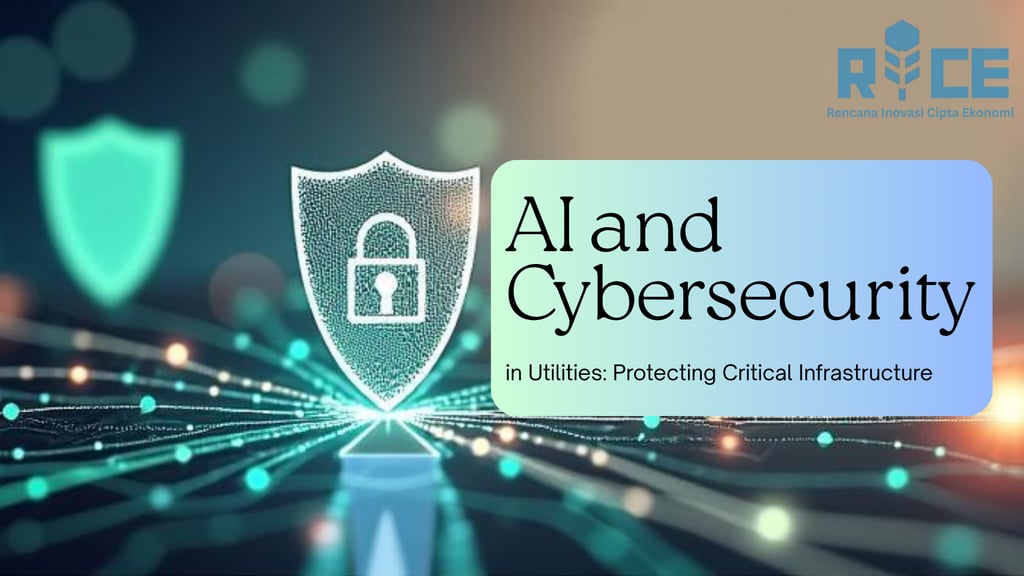AI & Cybersecurity in Utilities: An Ultimate Historical Guide to Protecting Critical Infrastructure
Explore the evolution of cybersecurity in utilities, from physical defenses to AI integration.
TECHNOLOGY
Rice AI (Ratna)
10/16/20257 min read


The foundation of modern society hinges on the unwavering reliability of its utilities: power, water, gas, and communications. Historically, protecting this critical infrastructure involved physical barriers and vigilant human oversight. Today, however, the battleground has shifted dramatically, with digital threats posing an increasingly sophisticated and pervasive danger. Understanding this evolution, from rudimentary defenses to the cutting-edge integration of Artificial Intelligence (AI) in cybersecurity, is paramount for safeguarding our essential services.
This ultimate guide delves into the historical trajectory of cybersecurity in the utility sector. We will explore how early, isolated systems gradually became interconnected, exposing them to unprecedented digital vulnerabilities. Furthermore, we will chart the escalating sophistication of cyber threats and examine AI’s pivotal role in transforming reactive defense strategies into proactive, predictive safeguards. Protecting critical infrastructure requires an informed, forward-thinking approach, recognizing that the past holds vital lessons for future resilience in an ever-evolving threat landscape.
The Genesis of Risk: From Physical Sabotage to Digital Vulnerabilities
Before the widespread adoption of digital technologies, utility infrastructure faced threats that were largely physical. The evolution of operational control systems, however, introduced a new dimension of risk, shifting the focus from purely physical security to the complex domain of cyber defense. Understanding this initial phase is crucial for appreciating the challenges utilities face today.
Analog Era Security: Physical Barriers and Operational Isolation
In the early days, protecting utilities primarily involved robust physical security measures. Fences, guards, and controlled access points were the front line of defense against sabotage, espionage, and vandalism. Operational control systems, if they existed, were often electromechanical, self-contained, and entirely air-gapped from any external networks. This inherent isolation acted as a natural cybersecurity barrier, albeit an unintentional one.
The simplicity of these systems meant that potential attackers needed direct physical access to cause disruption. Consequently, the focus was on deterring and preventing unauthorized entry into facilities. Operational technology (OT) was distinct from any nascent information technology (IT), ensuring that any vulnerabilities remained localized and difficult to exploit remotely.
The Dawn of Connectivity: Introducing SCADA Systems and Initial Exposures
The introduction of Supervisory Control and Data Acquisition (SCADA) systems marked a significant turning point. These systems enabled centralized monitoring and control of dispersed utility assets, offering unprecedented efficiency and operational visibility. However, their burgeoning connectivity—first within localized networks, then slowly extending outwards—began to erode the natural air gaps that once safeguarded critical infrastructure.
As SCADA systems became more sophisticated, integrating with basic IT networks for data sharing and remote management, new vectors for attack emerged. While initially considered secure due to proprietary protocols and perceived obscurity, these systems represented the earliest forms of digital vulnerabilities. The utility sector began to grapple with the unfamiliar concept that an attacker could disrupt operations without ever setting foot on-site.
A New Frontier of Warfare: The Rise of Nation-State Attacks and Sophisticated Malware
The turn of the millennium ushered in an era where cyber threats evolved from nuisances to instruments of strategic warfare. The utility sector, due to its critical nature, became a prime target, necessitating a dramatic rethink of cybersecurity strategies. This period marked the stark realization that digital attacks could have real-world physical consequences.
Stuxnet and the Wake-Up Call: Understanding Targeted Attacks
No event underscored the gravity of cyber-physical attacks more profoundly than Stuxnet in 2010. This highly sophisticated malicious computer worm specifically targeted industrial control systems (ICS), particularly Siemens PLCs used in Iran's nuclear program. Stuxnet demonstrated an unprecedented level of complexity, leveraging multiple zero-day vulnerabilities and effectively crossing the IT/OT divide to cause physical damage to centrifuges.
Stuxnet was a watershed moment, revealing that critical infrastructure was not only vulnerable but also a viable target for nation-state actors. It highlighted the urgent need for dedicated OT security strategies, distinct from traditional IT security, and spurred global efforts to enhance the resilience of industrial control systems against such advanced persistent threats (APTs). This incident forced utilities worldwide to re-evaluate their security postures and invest in specialized defenses.
Proliferation of Advanced Persistent Threats (APTs)
Following Stuxnet, the landscape of cyber threats against utilities witnessed a proliferation of Advanced Persistent Threats (APTs). These are highly targeted, stealthy cyberattacks carried out by well-resourced groups, often state-sponsored, aiming for long-term infiltration and data exfiltration or disruption rather than quick financial gain. APTs typically involve extensive reconnaissance, social engineering, and the use of custom malware designed to evade conventional security measures.
Utility companies became attractive targets for APT groups seeking to map networks, deploy surveillance capabilities, or position themselves for future disruptive operations. The goal often extends beyond mere data theft, encompassing the potential to disrupt power grids, water treatment plants, or gas pipelines, causing widespread societal and economic chaos. This era emphasized the importance of threat intelligence sharing and sophisticated detection capabilities to counter these persistent, evolving threats.
AI's Transformative Role: Shifting the Paradigm of Defense
As cyber threats became more sophisticated and overwhelming in volume, traditional rule-based security systems proved inadequate. This critical gap paved the way for Artificial Intelligence (AI) and Machine Learning (ML) to emerge as indispensable tools, shifting cybersecurity from a reactive posture to a proactive and predictive one. AI’s ability to process vast datasets and identify complex patterns offered a new frontier in defense.
Early Applications of Machine Learning in Threat Detection
The initial integration of AI in utility cybersecurity focused on machine learning algorithms for threat detection. Traditional security relied on signature-based detection, effective against known threats but blind to novel attacks. ML, conversely, enabled anomaly detection. By continuously analyzing network traffic, system logs, and operational data, ML models could establish baselines of "normal" behavior. Deviations from these baselines, even subtle ones, could then be flagged as potential security incidents.
This capability was revolutionary for identifying zero-day exploits and polymorphic malware that constantly changes its signature. Early applications included identifying unusual login patterns, unexpected data transfers, or anomalous command executions within industrial control systems. While these early systems faced challenges with false positives due to the complex and often unpredictable nature of OT environments, they laid the groundwork for more refined AI-driven defenses.
Leveraging AI for Enhanced Situational Awareness and Response
Beyond mere detection, AI began to play a crucial role in improving overall situational awareness and automating incident response. AI-powered security orchestration, automation, and response (SOAR) platforms emerged, capable of correlating alerts from disparate security tools, prioritizing threats based on severity, and initiating automated response playbooks. This dramatically reduced response times and minimized the impact of attacks.
Furthermore, AI-driven threat intelligence platforms started to fuse data from global threat feeds, internal security events, and historical attack patterns to provide predictive insights. This allowed utilities to anticipate potential attack vectors, identify vulnerabilities proactively, and strengthen their defenses before an attack could even materialize. The integration of AI has moved cybersecurity from merely identifying breaches to actively predicting and preventing them, providing a much-needed edge in a constantly escalating arms race against cyber adversaries.
Securing Tomorrow: Advanced AI, Digital Twins, and Zero Trust
The current and future landscape of utility cybersecurity is defined by an accelerating convergence of technologies and an ever-expanding attack surface. Advanced AI, combined with innovative frameworks like Zero Trust and methodologies such as digital twins, is becoming the essential backbone for maintaining resilience in critical infrastructure. This proactive stance is non-negotiable for safeguarding vital services.
The Convergence of AI, IoT, and 5G in Critical Infrastructure
The widespread deployment of the Internet of Things (IoT) and Industrial Internet of Things (IIoT) devices throughout utility networks, coupled with the rollout of 5G connectivity, presents both immense opportunities and significant cybersecurity challenges. Billions of new sensors, smart meters, and connected devices generate unprecedented volumes of data, enabling greater efficiency and granular control. However, each connected device represents a potential entry point for attackers, expanding the attack surface exponentially.
5G, with its high bandwidth and low latency, further accelerates this data flow and interconnectivity, making traditional perimeter-based security models obsolete. In this environment, human analysts alone cannot cope with the scale and complexity of potential threats. AI is not merely an optional enhancement but an absolute necessity. AI algorithms can monitor, analyze, and secure this vast, dynamic ecosystem in real-time, identifying subtle anomalies and orchestrating responses at a speed and scale impossible for humans. Without AI, the promise of smart grids and connected utilities would remain perpetually vulnerable.
AI-Powered Strategies for Resilience: Zero Trust and Digital Twins
To address the complexities of modern critical infrastructure security, advanced AI is being integrated with strategic cybersecurity frameworks like Zero Trust. A Zero Trust architecture fundamentally asserts that no user, device, or application, whether inside or outside the network, should be trusted by default. Every access attempt must be verified. For OT environments, adapting Zero Trust principles means rigorous authentication and authorization for every interaction, micro-segmentation of networks, and continuous monitoring of all activities. AI enhances Zero Trust by providing the intelligence to continuously assess trust levels, detect anomalous behavior indicative of compromise, and dynamically adjust access policies in real-time.
Another powerful application of AI is in the realm of digital twins. A digital twin is a virtual replica of a physical system—in this case, an entire utility grid or a specific industrial plant. AI-driven digital twins can simulate the complex behaviors of these systems, including their cybersecurity vulnerabilities. This allows security teams to model different attack scenarios, test the effectiveness of new security controls without risking live operations, and even predict the impact of a breach. Companies like Rice AI are at the forefront of developing these sophisticated AI-powered digital twin solutions, enabling utilities to build and test their resilience in a safe, virtual environment before deploying changes to critical live systems. These simulations provide invaluable insights, helping utilities proactively harden their defenses against an array of known and emerging threats.
Conclusion
The journey of cybersecurity within the utility sector is a compelling narrative of continuous adaptation and innovation, mirroring the relentless evolution of the digital world. From the robust simplicity of physical defenses to the intricate dance of modern cyber warfare, utilities have consistently faced the daunting task of protecting the very backbone of society. The Stuxnet incident served as a stark, global wake-up call, emphasizing that critical infrastructure is a prime target for sophisticated, state-sponsored attacks capable of real-world destruction. This historical perspective underscores why the current and future integration of Artificial Intelligence is not merely an advantage, but an absolute imperative.
AI has fundamentally transformed cybersecurity from a reactive, signature-based defense to a proactive, predictive, and intelligent system. It empowers utilities to navigate the ever-expanding attack surface created by IoT, IIoT, and 5G, detecting anomalies and responding to threats with unprecedented speed and precision. Strategic frameworks like Zero Trust, coupled with AI-driven digital twins, provide the tools to build truly resilient systems capable of anticipating and mitigating risks before they materialize. The scale and complexity of contemporary threats demand intelligent automation and analytical power that only AI can provide.
Protecting critical infrastructure demands unwavering vigilance, continuous investment, and a commitment to leveraging the most advanced technologies available. For utilities looking to fortify their defenses and ensure the uninterrupted delivery of essential services, partnering with specialized AI cybersecurity experts is crucial. Companies like Rice AI are dedicated to providing the cutting-edge solutions necessary to secure these vital assets against the cyber threats of today and tomorrow. Embrace the power of AI to not just defend, but to proactively future-proof our critical infrastructure. Invest in advanced AI cybersecurity today to guarantee the reliability and safety of our shared future.
#AICybersecurity #CriticalInfrastructure #UtilitySecurity #OTSecurity #ICSDefense #AIinUtilities #CyberResilience #SmartGridSecurity #ZeroTrust #DigitalTwins #PredictiveSecurity #CyberThreats #IndustrialCybersecurity #FutureofSecurity #RiceAI #DailyAITechnology
RICE AI Consultant
To be the most trusted partner in digital transformation and AI innovation, helping organizations grow sustainably and create a better future.
Connect with us
Email: consultant@riceai.net
+62 822-2154-2090 (Marketing)
© 2025. All rights reserved.


+62 851-1748-1134 (Office)
IG: @riceai.consultant
